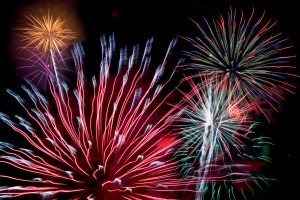Fireworks night is a busy time of year for many First Aid Companies, our job is keeping members of the public safe from harm.
The two largest injuries seen are Burns from sparklers and bangers being lit in a persons hand.
Burns is the biggest injury, and treating burns fast can reduce suffering (stop the burning from getting worse) and healing time.
What to do for a Firework Burn or Scald

- Stop the burning process as soon as possible. This may mean removing the person from the area, dousing flames with water or smothering flames with a blanket. Do not put yourself at riskof getting burnt as well.
- Remove any clothing or jewellery near the burnt area of skin. However, don’t try to remove anything that is stuck to the burnt skin because this could cause more damage.
- Cool the burn with cool or lukewarm water for 10 to 30 minutes, ideally within 20 minutes of the injury occurring. Never use ice, iced water or any creams or greasy substances such as butter (old wives tale!).
- Keep yourself or the person warm. Use a blanket or layers of clothing, but avoid putting them on the injured area. Keeping warm will prevent hypothermia, where a person’s body temperature drops below 35ºC (95ºF). This is a risk if you are cooling a large burnt area, particularly in young children and elderly people.
- Cover the burn with cling film. Put the cling film in a layer over the burn, rather than wrapping it around a limb. A clean clear plastic bag can be used for burns on your hand.
- Treat the pain from a burn with paracetamol or ibuprofen. Always check the manufacturer’s instructions when using over-the-counter (OTC) medication. Children under 16 years of age should not be given aspirin.
When to go to hospital
Once you have taken these steps, you will need to decide whether further medical treatment is necessary. Go to a hospital accident and emergency (A&E) department for:
- large or deep burns – any burn bigger than the affected person’s hand
- full thickness burns of all sizes – these burns cause white or charred skin
- partial thickness burns on the face, hands, arms, feet, legs or genitals – these are burns that cause blisters
- all chemical and electrical burns
Also get medical help straight away if the person with the burn:
- has other injuries that need treating
- is going into shock – signs include cold clammy skin, sweating, rapid shallow breathing and weakness or dizziness
- is pregnant
- is over 60 years of age
- is under five years of age
- has a medical condition such as heart, lung or liver disease, or diabetes
- has a weakened immune system (the body’s defence system), for example because of HIV or AIDS, or because they’re having chemotherapy for cancer
If someone has breathed in smoke or fumes, they should also seek medical attention. Some symptoms may be delayed and can include coughing, a sore throat, difficulty breathing, singed nasal hair or facial burns.
The above is only for BURNS FROM FIREWORKS. For Electrical, Chemical or Sunburn please contact 111 or if life threating 999.
If you need medical cover at your event please ask us for a quote